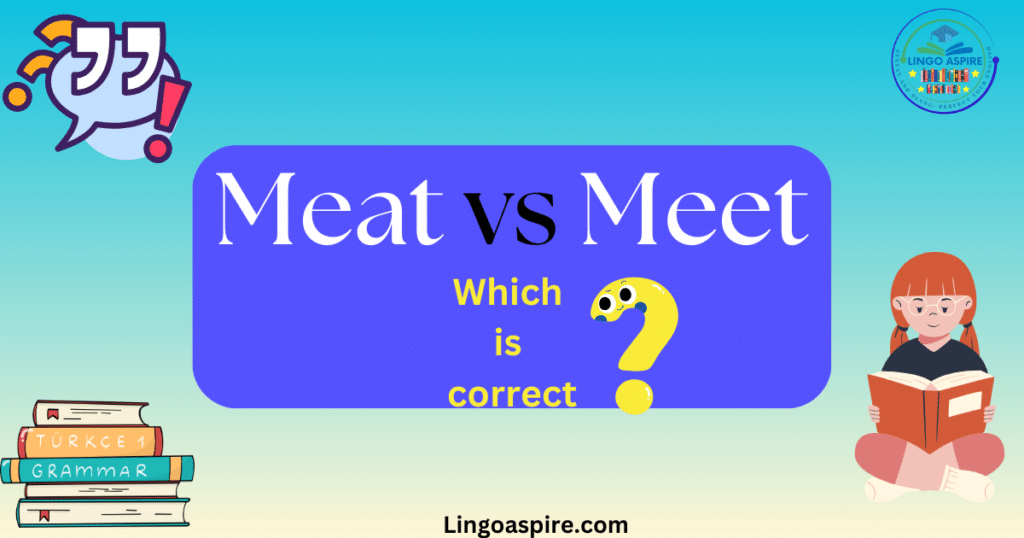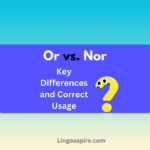Meat vs. Meet—these two words may sound the same, but they have completely different meanings and usages. Understanding the difference between meat and meet is crucial for clear communication, whether you are writing, speaking, or just having a conversation. In this article, we will dive into each word’s definitions, usage, and provide helpful tips to help you understand when and how to use them correctly.
While they may seem simple, meat and meet are often confused because they are homophones. That means they sound alike but are spelled differently and have different meanings. The importance of knowing the right spelling cannot be overstated, as it can affect how your message is received.
The Core Difference Between Meat and Meet
At first glance, meat and meet might seem like they could be interchangeable. After all, they both share the same pronunciation. But they belong to different parts of speech, and understanding their core difference is key to using them properly.
Meat: Noun
The word meat is a noun, and it refers to the flesh of animals, often consumed as food. Examples of meat include beef, pork, chicken, lamb, and venison. It is an essential part of the diet for many people, offering important nutrients like protein and iron. In addition to its literal meaning, meat can also be used figuratively to describe the main part or core of something. For instance, “Let’s get to the meat of the problem” refers to focusing on the most important or central part of an issue.
Meet: Verb
On the other hand, meet is a verb, meaning to come together with someone or something, either for the first time or in a social, business, or professional context. It could also refer to an event where people gather, such as a meet-and-greet or a business appointment. Meeting is about interaction and connection, whether it’s with a person, a group, or an idea. For example, “I’ll meet you at the coffee shop later today” or “We plan to meet in the conference room at noon.”
While meat is primarily used in culinary contexts, meet is all about social and professional interactions. Knowing how to distinguish between these two words is essential to avoiding mistakes that could confuse your listeners or readers.
How to Use ‘Meat’ in a Sentence
The word meat is used most commonly in culinary discussions, related to food preparation and consumption. It is also used when talking about dietary choices or recipes.
Sentence Examples:
- “I love eating meat, especially red meat like beef.”
- “My doctor recommended cutting down on meat to improve my health.”
- “The butcher sells fresh meat every day.”
In each of these examples, meat refers to the flesh of animals that is prepared and consumed as food. It is often part of the main course in a meal. The butcher is someone who specializes in cutting and selling meat. Meat can also refer to processed meats like sausages, bacon, or deli cuts.
In a figurative sense, meat can refer to the main or core part of something, such as an issue, discussion, or text. For example, “The meat of the story is about personal sacrifice.”
More Examples of Meat in Sentences:
- “Eating more lean meats can help improve your diet.”
- “The meat of the article focuses on the economic impact of the new law.”
- “She prepares amazing barbecue meat for the family gatherings.”
Meat is used in many contexts, from discussing dietary choices to describing the central or most important part of something.
How to Use ‘Meet’ in a Sentence
As a verb, meet is used when talking about encounters, social interactions, and business appointments. You might meet a friend for coffee, meet a client for a presentation, or even attend a meet-and-greet event where people gather to make introductions.
Sentence Examples:
- “I can’t wait to meet my old friends this weekend.”
- “Let’s meet in the conference room at 2 PM to discuss the project.”
- “They will meet their colleagues at the event later today.”
In these examples, meet is used to describe an action—the encounter between two or more people. It could also refer to any kind of interaction, whether in a personal, social, or professional context. The key to understanding meet is recognizing it as the action of coming together or interacting with someone or something.
In the present participle form, meet becomes meeting, which is commonly used to describe ongoing or future encounters:
- “I will be meeting with my manager later today.”
- “They are meeting for lunch tomorrow.”
Pronunciation and Parts of Speech: A Quick Overview
While meat and meet are pronounced the same (/miːt/), they are different in terms of their parts of speech.
- Meat is a noun used to refer to animal flesh or the core of something.
- Meet is a verb used when talking about encounters or interactions.
It’s essential to recognize these two different roles because, without understanding the context, the sentence might not make sense.
| Word | Definition | Examples | Usage Context |
|---|---|---|---|
| Meat (noun) | Refers to animal flesh (food) | “I’m cooking meat tonight.” | Used in culinary contexts or dietary discussions |
| Meet (verb) | Refers to the act of encountering or interacting | “We’ll meet at the park tomorrow.” | Used for social, professional, and casual gatherings |
Both words are pronounced the same, but the meaning changes depending on whether you’re talking about food or an encounter. Understanding their definitions and uses helps ensure clear communication.
Common Phrases: How ‘Meat’ and ‘Meet’ Appear in Everyday Speech
There are several common phrases where meat and meet are often confused. Misusing these words can lead to misunderstandings, so let’s look at some common phrases to clear up any confusion.
- “Make ends meet” is the correct phrase. This means to manage your finances or budget well enough to cover basic living expenses.
- “Meet and greet” is also a widely used expression, especially in business appointments and social gatherings. It refers to a situation where people come together to introduce themselves.
Using meat in these phrases would be incorrect and nonsensical. For instance, saying “Make ends meat” or “Meat and greet” would confuse your listener, as they would expect meat to refer to animal flesh, not an event or financial expression.
Another commonly used phrase is “You’re dead meat,” which means that someone is in serious trouble or danger. If you said “You’re dead meet,” it wouldn’t make sense in any context, as the word meet does not fit the meaning.
Clarification of Key Phrases:
- Make ends meet – Correct (managing finances)
- Meet and greet – Correct (an event for introductions)
- You’re dead meat – Correct (you’re in trouble)
Meet vs. Meat: A Quick Summary
Understanding the difference between meat and meet boils down to two main distinctions: meat is a noun referring to animal flesh or the core part of something, while meet is a verb used to describe an encounter or interaction. Both words may sound identical, but they have different meanings and uses, and recognizing when to use them is crucial for avoiding confusion.
Here’s a quick comparison:
| Word | Definition | Usage Context | Examples |
|---|---|---|---|
| Meat (noun) | Refers to animal flesh, typically for food | Used in recipes, dietary discussions, and culinary contexts | “I prefer beef meat” |
| Meet (verb) | Refers to encountering or coming together | Used for business appointments, social interactions, and casual gatherings | “Let’s meet at 3 PM” |
Frequently Asked Questions (FAQs)
Let’s address some of the most common questions people have about meat vs. meet:
Which is correct: “Make ends meet” or “Make ends meat”?
The correct phrase is “Make ends meet,” which refers to managing one’s financial resources to cover basic expenses. “Make ends meat” is an incorrect and nonsensical usage.
Which is correct: “Meet and greet” or “Meat and greet”?
“Meet and greet” is the correct term. It describes an event where people come together to introduce themselves to one another. “Meat and greet” would be an error and wouldn’t be understood in this context.
Should it be “You’re dead meat” or “You’re dead meet”?
“You’re dead meat” is the correct expression. It’s slang meaning that someone is in serious trouble. Saying “You’re dead meet” would be a grammatical mistake and doesn’t convey any meaningful message.
Conclusion
In conclusion, the difference between meat and meet is clear once you understand their roles in language. Meat is a noun referring to animal flesh used for food, while meet is a verb used to describe interactions or encounters. Whether you’re talking about food or social interactions, getting the spelling and meaning right is important for clear communication. By keeping these distinctions in mind, you can confidently use both words in your writing and speaking.
Now that you know the difference between meat and meet, you can avoid the common mistakes that many people make when using these words. Whether you’re discussing your dietary preferences or planning a casual gathering, always use the correct word in the right context.
Sources
- Grammarly: This article discusses the meanings and uses of “meat” and “meet,” highlighting their roles as homophones with distinct definitions.
- ProWritingAid: This resource offers a clear explanation of the differences between “meat” and “meet,” including their definitions and common usage scenarios.
- Grammarist: This page explores the definitions, origins, and examples of “meat,” “meet,” and “mete,” providing a comprehensive understanding of these homophones.







